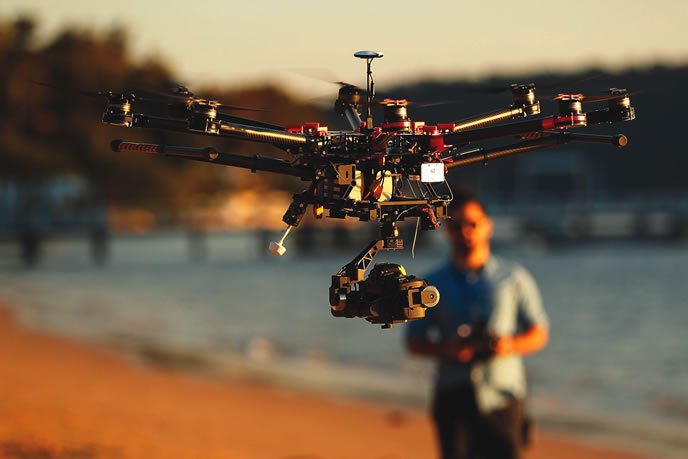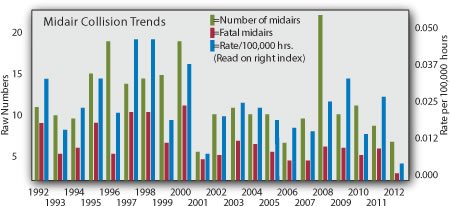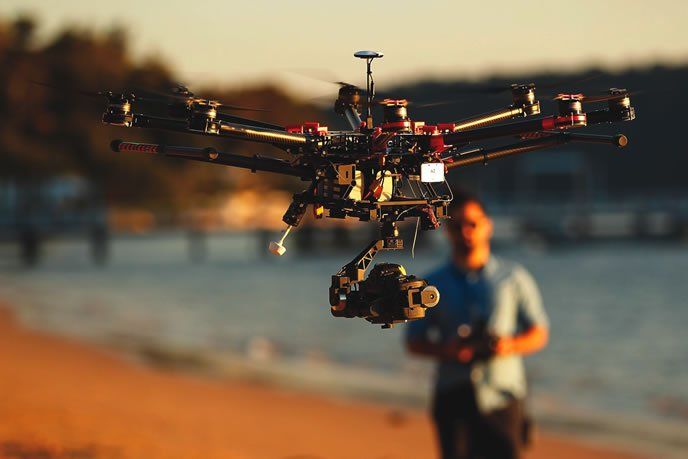The technology you have in your glass panel, smartphone and the tablet you use in the cockpit? It turns out the same hardware and software putting a blue dot on a moving map—and displaying an accurate artificial horizon—also can be used to operate a small, airborne robot: a drone. Formally known as an unmanned aircraft system, UAS, they’ve grown in sophistication and utility to the point Congress in 2012 told the FAA to come up with a framework integrating them into the national airspace system.

In response, the FAA in February published its vision of how it all should work, stopping short of requiring elaborate training or certification standards, and proposing a basic set of operating rules. One way to look at the proposed rule is that it potentially allows small UAS (sUAS), those weighing up to 55 pounds (25 kilograms) to share the sky with aircraft carrying lots of healthy pink bodies. Airspace sharing would be rare, subject to ATC jurisdiction and designed to minimize—but not eliminate—the risk of collision with manned aircraft.
The Proposal
The FAA always has held commercial aircraft operations to a higher standard, strictly regulating how a private pilot may share flying expenses among friends or participate in formal ride-sharing programs, for example. As one result, there simply aren’t that many regulations applying to recreational aviation activities compared to those addressing carriage of persons or property for hire. Current FAA rules basically exempt recreational UAS—model airplanes—from the sort of operating requirements the agency’s new proposal would implement.
The agency’s proposed rules on non-recreational operation of small unmanned aerial systems (sUAS) breaks some new ground. It tries to apply some manned-aircraft rules to the machines and their operators, even as it adopts those proven features of model airplane rules. The proposal forgoes the opportunity to certify sUAS types and seeks only minimal operator certification, but also would require aircraft registration and displaying an N-number. The sidebar on the opposite page highlights some of the proposed rule’s provisions.
The FAA’s proposal is just that: a starting point for discussion. The agency set April 24, 2015, as a deadline for comments from the public and industry; we wouldn’t be surprised if it’s extended. Since it’s taken the FAA some three years to get this far down the path of UAS regulation, it’s not likely a consensus will be reached and a final rule published until, maybe, the end of 2016. Don’t hold your breath.
In the meantime, the status quo remains: Basically, non-recreational use of sUAS isn’t legal unless explicitly exempted by the FAA. Operators needing an exemption would be smart to use the NPRM as a template when seeking it.
Avoiding Mid-Airs
Noting the see-and-avoid concept is a “fundamental principle” of collision avoidance in the national airspace system, the FAA aptly states the concern many pilots have about mid-air collisions with sUAS: “whether the person operating the small unmanned aircraft, who would be physically separated from that aircraft during flight, would have the ability to see manned aircraft in the air in time to prevent a mid-air collision.” The challenge, according to the agency, is to “ensure that the person operating the small unmanned aircraft is able to see and avoid other aircraft.”
As highlighted above, an sUAS operator must maintain unaided visual contact with it, and basic VFR visibility minimums are required. Is that going to be sufficient? What about if the operator loses what the FAA calls “positive control” of sUAS? The agency “proposes to mitigate the risk associated with loss of aircraft control by confining small unmanned aircraft to a limited area of operation.” It envisions multiple observers positioned at the “outer bounds of the horizontal circle created by the visual line-of-sight requirement.” The proposal seeks comment on a flight-termination capability for when the operator loses contact with the sUAS and it motors off on its own, but the FAA didn’t suggest actions the operator or the observers are supposed to take if control is lost. Perhaps each observer should be armed with a shotgun?

Reaction
While the FAA’s small UAS NPRM drew positive if subdued reaction from trade and member groups we spoke to, the same can’t be said for some individual pilots and aircraft owners. Many are rightly asking what data the FAA used to determine that sUAS represent no significant safety risk for manned aircraft. So did we, so we asked, or at least our sister publication, AVweb.com did.
The FAA’s UAS branch replied that it relied on the 2009 report of the Small UAS Aviation Rulemaking Committee for guidance. The ARC described what it called a “layered approach” to mitigating risk and it offered this: “Many of the committee’s recommendations were made based on experience with existing aviation operations and regulations and perceptions of risk.”
Perceptions are one thing, but did anyone put any numbers on this with actual statistical risk analysis? Not exactly. At least no one in the manned aviation community seems to have such data. More on that in a moment.
The Air Line Pilots Association seems most alarmed about the UAS collision risk and is urging the FAA to require extensive training and regulation of operators. But they declined comment on what risk analysis they used to reach this conclusion and whether it should be applied to sUAS. AOPA, EAA and HAI generally lauded the NPRM as a good first step. Any numerical risk analysis there? Nope. Surely the insurance companies have? No again, at least for the two we spoke to.
Got DATA?
The reason for this seeming dearth of analysis is that there’s simply no reliable data to work with. The big scary number comes from the Academy of Model Aeronautics, which estimates the population of sUAS to be about 400,000—that’s everything from Parrot BeBops bought at Hobby Lobby to Hollywood octocopters capable of hefting digital cinema cameras. No one we spoke to has a clue about the distribution of this population, geographically or by sUAS type. Adding to the worries—some say hysteria—is the FAA’s growing number of pilot sUAS sightings, which was nearing 200 at last count. Their Pireps are routinely making the evening news.
We asked the NTSB to comment on these reports, but the agency declined to do so. However, we spoke to former board member John Goglia who’s been following the UAS issue, including FAA sighting data.
“The FAA just asked for a data dump, for anything that involved a UAV,” Goglia told us. “Those particular data points do not constitute enough for you make a decision upon. Any researcher who looks at these would not give them any serious credibility,” Goglia adds. The sightings are too vague and lack confirmation and Goglia doesn’t place much credence in pilot perception of distance, speed and relative risk.
The FAA’s sighting data gives the impression that a collision and perhaps an accident is inevitable, but Goglia isn’t convinced. “First of all, today’s [transport category] airplanes are certified to take a hit from an eight-pound bird. And the 2.5-pound Phantom doesn’t have the same mass,” he argues. In theory, he says, a drone strike could cause a lot of damage; in practice, he thinks not.
The hard parts in small UAS do make a difference, Goglia says, but not much. How about [turbine] engine ingestion? “I don’t think it would go through the core, but through the centrifugal outside. It would cause some tooth decay on the fan blades. I think the engines won’t miss a beat,” Goglia said. For light GA, Goglia thinks the risk is slightly higher, but also mitigated by the lower speeds small aircraft fly.
Judging The Risk
But to judge the collision risk, the likelihood of it happening in the first place is a critical element. Our quest to find those numbers led us to the UAS community, which has modeled the risk, albeit based on the unknown input of sUAS populations and flight habits. The Autonomous Flight Systems Laboratory at the University of Washington has undertaken several research projects aimed at examining the collision risk and determining whether sense and avoid technology for sUAS would be effective or even necessary in reducing risk. The results proved illuminating.
Working in the same data desert as everyone else, the researchers decided to use gas motion theory—the random collision of gas molecules—as a model for drone/manned aircraft collisions, absent any active anti-collision gear. To prove the concept, they compared collisions the gas data predicted with actual mid-air stats from the NTSB’s records.
The two data sets aligned well enough to prove two things: See and avoid only works about 15 percent of the time—although it’s improving—and the mid-air collision risk is, statistically, quite low and largely driven by the same random chance as gas movement. Data AVweb developed shows that even in the worst recent years, with as many as 23 mid-airs in 2008, the actual mid-air rate is 0.039/100,000 hours. That’s roughly one every million flight hours. Since about 2005, probably due to the wider use of anti-collision equipment, the rate is half that. It’s a miniscule fraction of other risks like loss of control, fuel exhaustion and engine failure.
Furthermore, although mid-airs are thought to be 100 percent deadly, they were fatal in only 53 percent of accidents between 1991 and 2013. AVweb‘s mid-air collision data, for the years 1992 through 2012, is summarized in the graph on the opposite page.
Size Matters
Tad McGeer of Aerovel Corp., is a veteran entrepreneur of the robotic aircraft industry who’s active with the University of Washington research group. He’s also a 2500-hour instrument-rated pilot. McGeer authored his own inquiry and points out that part of collision risk is proportional to the sum of the sizes of the aircraft involved. Bigger aircraft represent more risk, smaller ones less.
“The point is, VFR-to-VFR collisions occur at the maximum molecule rate. If you’re flying around VFR where collisions occur at random, see and avoid is completely ineffective. No pilot should be surprised by that,” McGeer says. “So the risk of adding an unmanned aircraft to the airspace is the same as adding a manned aircraft,” McGeer argues.
The fact that sUAS are a fraction of the size of manned aircraft reduces the risk somewhat, but it’s the randomness that rules. “The data say that the fact that the manned aircraft supposedly has someone looking out the window makes no difference,” McGeer says. That’s another way of saying it doesn’t much matter that you don’t see the sUAS.
Throwing birdstrikes into the equation more or less proves the data. There are orders of magnitude more birdstrikes than mid-airs, because there are billions of birds and only thousands of airplanes. Despite some 2200 reported birdstrikes a year, strikes that cause fatal light aircraft GA accidents are, again, a tiny fraction of even the already low rate of mid-airs.
As an aside, the view from inside the UAS community is that collisions with people and objects on the ground are a vastly greater risk than mid-air collisions are because robotic aircraft remain far less reliable than manned aircraft and might be expected to crash every 1000 hours or less. The Washington Post has reported that nearly half of all the Predator drones built have crashed.
Still, McGeer doesn’t dismiss the sUAS risk entirely. “I certainly wouldn’t want to hit one. I would much rather hit a bird than something with hard parts in it,” he told us. He believes the profusion of sightings of sUASs flying where they shouldn’t is due to technology that has lowered the entry barrier; anyone can buy and fly them. “Having said that, it’s not a huge risk having them fly around where they ought not to be,” McGeer says.
John Goglia has a similar view. He by no means describes the sUAS risk as zero, but he also believes shrill news reports on ever more drone sightings don’t inform the ability of pilots to judge risk in the slightest. He thinks the FAA ought to leave small drones—say under four pounds—completely out of the regulatory equation and expend intense effort on educating the operators who are flying them in proximity to manned aircraft. McGeer told us he wonders if the whole quadcopter thing is just a fad that will eventually fade. If he’s right, perhaps we’ve got a self-solving problem, at least for small or micro UAS.
Bottom Line?
If the FAA’s proposed rule on sUAS operation goes into effect as drafted, separation from other aircraft in Class A-D airspace will be the joint responsibility of ATC and the operator. Those of us who fly from non-towered airports in Class E or G airspace from time to time—most of us—will depend on see-and-avoid techniques to avoid mid-air collisions. So will the sUAS operator. It’s still a big sky, and the small size, and infrequent and short-duration nature of an sUAS’s flight poses minimal risk to other aircraft. That risk, however, is not zero.
The success or failure of any avoidance scheme depends sUAS operators complying with the final rule and taking seriously their responsibilities to avoid other aircraft. For example, the sUAS operator will be responsible for identifying any airports near the proposed operating area, and remaining clear of routes taken by manned (peopled?) aircraft using it. Based on anecdotal evidence seemingly reported daily in the media, it’s not at all clear that will be the case. Yet, without any real data on the numbers of sUAS in the field, how often they’re operated, where, for what purposes and by whom, it’s impossible to estimate the additional risk.




